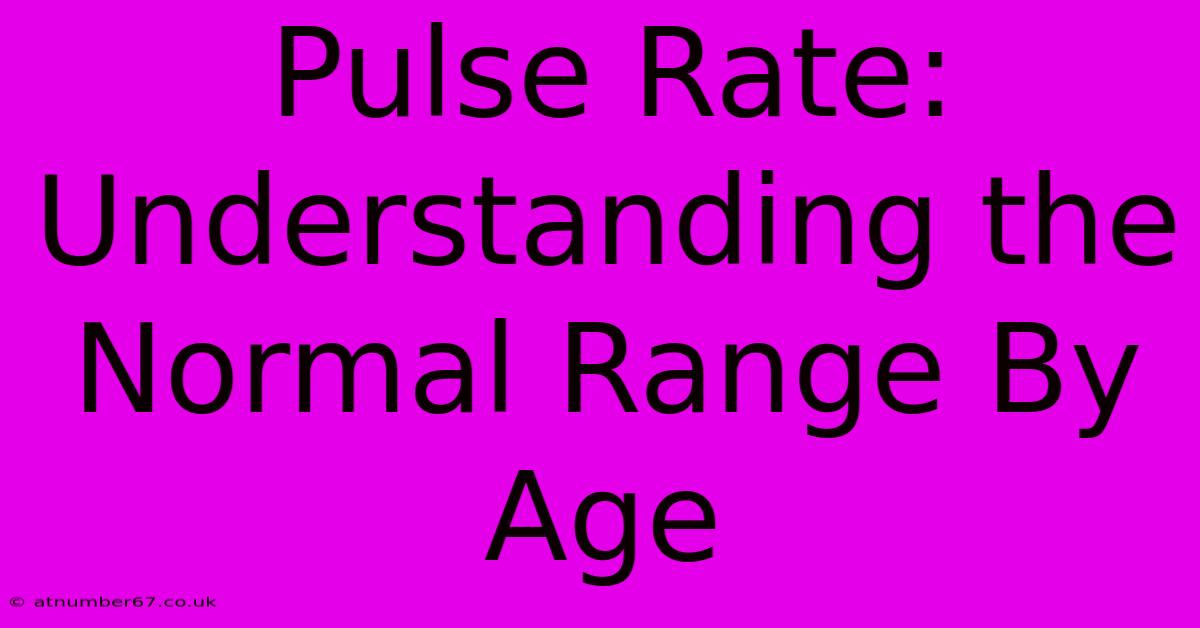Pulse Rate: Understanding The Normal Range By Age

Table of Contents
Pulse Rate: Understanding the Normal Range By Age
Your pulse, that rhythmic thump-thump-thump you feel when you touch your wrist or neck, is a direct reflection of your heart's health. Understanding your pulse rate – the number of times your heart beats per minute (BPM) – is crucial for maintaining good health and recognizing potential problems. This article explores the normal pulse rate range by age, factors that influence it, and when you should seek medical attention.
What is a Normal Pulse Rate?
A normal resting pulse rate generally falls between 60 and 100 beats per minute (BPM) for adults. However, this is just a general guideline. Your individual normal pulse rate can be influenced by several factors, making it essential to understand your own baseline.
Understanding the Variations
Age: As you'll see below, the normal pulse rate varies significantly across different age groups. Younger individuals tend to have faster heart rates than older adults.
Fitness Level: Highly trained athletes often have resting heart rates significantly lower than the average adult, sometimes even dipping below 60 BPM. This is due to increased cardiac efficiency.
Medications: Certain medications can influence your heart rate, either increasing or decreasing it.
Underlying Health Conditions: Various health conditions, such as heart disease, thyroid problems, and anxiety, can affect your pulse rate.
Body Temperature: A fever can cause your heart to beat faster.
Body Position: Your heart rate can be slightly higher when standing than when lying down.
Emotions: Stress, anxiety, or excitement can lead to an increased heart rate.
Normal Pulse Rate by Age Group
Here's a breakdown of the generally accepted normal pulse rate ranges by age:
- Newborns (0-1 month): 70-190 BPM
- Infants (1-11 months): 80-160 BPM
- Children (1-6 years): 75-115 BPM
- Children (6-12 years): 70-110 BPM
- Adolescents (12-18 years): 60-100 BPM
- Adults (18 years and older): 60-100 BPM
Important Note: These are just average ranges. Individual variations are common. It’s vital to consult with a doctor to establish your personal normal resting heart rate.
Measuring Your Pulse Rate
Measuring your pulse is simple:
- Find your pulse: Use your index and middle fingers to gently press against your wrist, just below the base of your thumb (radial artery), or along the side of your neck (carotid artery). Avoid using your thumb, as it has its own pulse that might interfere with your reading.
- Count the beats: Count the number of beats you feel for 60 seconds (one minute) to determine your BPM. Alternatively, count for 30 seconds and multiply by two for a quicker reading.
- Record your results: Keep track of your pulse rate at various times and under different conditions to establish a baseline.
When to See a Doctor
While variations in pulse rate are normal, you should consult a healthcare professional if:
- Your resting heart rate consistently falls outside the normal range for your age.
- You experience a sudden increase or decrease in your heart rate.
- You experience palpitations (a feeling of a rapid, fluttering, or pounding heartbeat).
- You feel lightheaded or dizzy.
- You experience chest pain or shortness of breath.
Regularly monitoring your pulse rate can be a valuable tool in maintaining your overall health. By understanding your normal range and being aware of any significant changes, you can proactively address any potential health concerns. Remember, this information is for general knowledge and should not replace professional medical advice. Always consult your doctor if you have any concerns about your heart health.

Thank you for visiting our website wich cover about Pulse Rate: Understanding The Normal Range By Age. We hope the information provided has been useful to you. Feel free to contact us if you have any questions or need further assistance. See you next time and dont miss to bookmark.
Featured Posts
-
Sanjana Gamarachchis Age A Public Figures Story
Apr 08, 2025
-
The Hidden Life Of Andre Ruth Ellis Son
Apr 08, 2025
-
January Littlejohns Daughter A Fathers Pride
Apr 08, 2025
-
Sam Verzosas Net Worth A Step By Step Guide
Apr 08, 2025
-
Natasha Jonas Net Worth And Investment Opportunities
Apr 08, 2025
